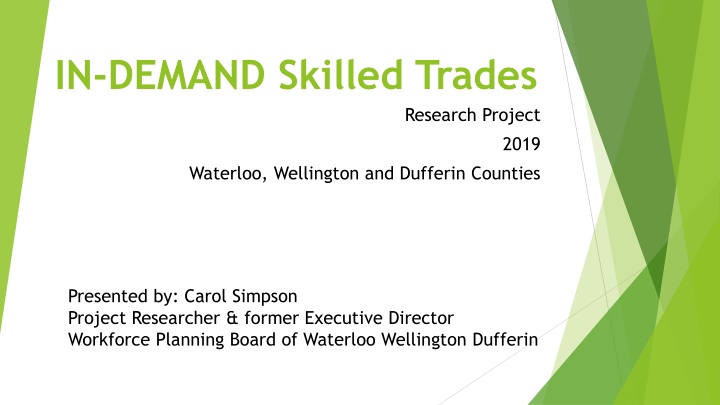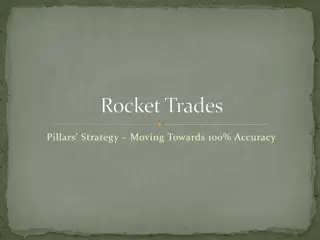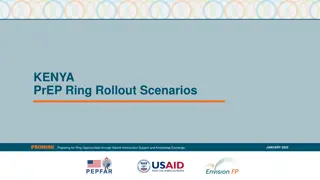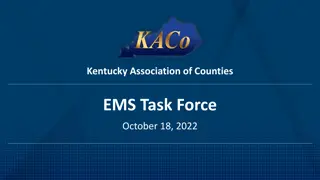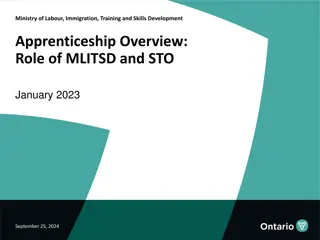Skilled Trades Research Project 2019 in Waterloo, Wellington, and Dufferin Counties
A comprehensive research project focusing on identifying in-demand skilled trades in Waterloo, Wellington, and Dufferin counties and addressing recruitment, training, and retention challenges. The project aims to provide insights for modernizing Ontario's skilled trades and apprenticeship system through surveys, focus groups, interviews, and stakeholder input.
Download Presentation

Please find below an Image/Link to download the presentation.
The content on the website is provided AS IS for your information and personal use only. It may not be sold, licensed, or shared on other websites without obtaining consent from the author.If you encounter any issues during the download, it is possible that the publisher has removed the file from their server.
You are allowed to download the files provided on this website for personal or commercial use, subject to the condition that they are used lawfully. All files are the property of their respective owners.
The content on the website is provided AS IS for your information and personal use only. It may not be sold, licensed, or shared on other websites without obtaining consent from the author.
E N D
Presentation Transcript
IN-DEMAND Skilled Trades Research Project 2019 Waterloo, Wellington and Dufferin Counties Presented by: Carol Simpson Project Researcher & former Executive Director Workforce Planning Board of Waterloo Wellington Dufferin
Project Goals Identify which skilled trades in Waterloo Wellington Dufferin were in-demand/hard to fill Identify issues with recruitment, training and retention of journeypersons and apprentices Get employers perspectives on the current system and what changes will be required to improve it
About the Project To provide input to the modernization of Ontario s skilled trades and apprenticeship system and help inform how government, industry and local communities can work together to support economic competitiveness in the province. External research On-line survey Focus groups One on one interviews with key stakeholders Validation and prioritization event
Project Geography This project looked at the communities within Waterloo, Wellington and Dufferin. All 26 planning board areas across Ontario were tasked with conducting similar and simultaneous research.
Source: Ontario Ministry of Training, Colleges and Universities, 2018-2019 Employment Ontario Data
Women in Trades Skilled Trades occupations with 85% or more female workers Skilled Trades occupations with <10 female workers Roofer Aboriginal/Child Development Practitioner 97% Agricultural Equipment Technician Educational Assistant 90% Steamfitter* Horse Groom 88% Facilities Mechanic Optics Technician (Lens & Prism Maker) 87% Terrazzo Tile and Marble Setter Special Events Coordinator 85% Ironworker Electric Motor System Technician Motorcycle Technician* Heat & Frost Insulator Elevating Devices Mechanic Small Engine Technician * Compulsory Trade Source: Statistics Canada, 2016 Census, Special Tabulations
Age Demographics 15-34 years Compulsory Skilled Trades occupations with highest % of workers aged 15-34 years Plumber 49% Refrigeration & Air Cond. Mechanic 46% Electrician 43% Sprinkler & Fire Protection Installer 41% Auto Service/Truck Technicians 38% Source: Statistics Canada, 2016 Census, Special Tabulations
Age Demographics 55+ All Skilled Trades occupations with highest % of workers aged 55+ years Agricultural Fruit Grower 48% Gemsetter/Goldsmith 45% Native Clothing and Crafts Artisan 44% Facilities Mechanic 39% Compulsory Skilled Trades occupations with highest % of workers aged 55+ years Sheet Metal Worker 24% Auto Body and Collision Repairer 20% Source: Statistics Canada, 2016 Census, Special Tabulations
Job Demand Between January 1-September 1, 2019 there were 49,898 jobs posted in Waterloo Wellington Dufferin. Of these, 14,000 or 28% are considered skilled trades occupations by the Government of Ontario Transport Truck Drivers 2,378 Customer Information Services 1,090 Automotive Service/Truck Technicians 700 Cooks 650 User Support Technicians 503 Source: Talent Neuron, Jan 1-Sept1, 2019
Unemployment in Skilled Trades Highest Unemployment Rates Steamfitter 6.6% 6.5% 5.9% Plumber Electrician (Construction & Maintenance) Lowest Unemployment Rates Motorcycle Technician 0% 2.2% 2.4% Residential Air Cond. Systems Mechanic Alignment & Brakes Technician Source: Statistics Canada, 2016 Census, Special Tabulations
In-Demand Skilled Trades INDUSTRIAL CONSTRUCTION General Machinist (429A) Welder (456A) CNC Programmer (670C) Cabinet Maker (438A) Industrial Electrician (442A) General Carpenter (403A) Industrial Mechanic Millwright (433A) Electrician Constr. & Maintenance (309A) Tool & Die Maker (430A) Plumber (306A) Tractor Trailer Commercial Driver (638A) MOTIVE POWER SERVICE Automotive Mechanic/Technician (310S) IT Network Technician (634C) Institutional Cook (415D) Chef (415C) Source: Statistics Canada, 2016 Census, Special Tabulations
Key Findings The vast majority of the discussion revolved around three key topic areas: Perceptions/Awareness Training, Completion & Retention Technical Issues/Process Source: In Demand Skilled Trades Technical Report December 2019
Perceptions/Awareness What constitutes a skilled trade occupation What occupations could or should be considered a skilled trade Non-clarity of the marketing of skilled trades as a career path Comparisons between compulsory/voluntary trades Still directing good with their hands students to skilled trades Small and Medium sized Employers (SMEs)/Employees unaware of available apprenticeship curriculum Source: In Demand Skilled Trades Technical Report December 2019
Training, Completion and Retention Two distinct trains of thought re: training for voluntary trades Concerns over curriculum Need for multi-skilled tradespersons/Blended trades Access to timely and available training seats Apprentices who are less academically inclined or with learning disabilities impacting completion Source: In Demand Skilled Trades Technical Report December 2019
Technical Issues/Process No apparent methodology for providing adequate training seats Financial hardship during block release/Timing for SMEs Confusion re: who in government is responsible for what re: trades/apprenticeships Lack of tax credits/grants for employers Source: In Demand Skilled Trades Technical Report December 2019
THANK YOU/MERCI! In-Demand Skilled Trades Technical Report December 2019.Pdf www.workforceplanningboard.com Carol Simpson: simpsonconsultservices@gmail.com For similar reports from other regions, please contact your local workforce planning board at www.workforceplanningontario.com
